Updated in April 2020
As kids growing up in Germany foraging was something we did naturally. I was blessed to grow up with a large garden that contained a wonderful variety of fruits and vegetables. Our big walnut tree was a central feature of the yard, as were black and red currant bushes, gooseberry bushes, apple, cherry and plum trees. But snacking for us kids was not limited to our garden! We also knew where to find the best wild strawberries, raspberries, blackberries, and hazelnuts.
Early Fall was and is my favorite season because our family loves going mushroom hunting. I have fond memories of spending many hours gathering chanterelles and porcini mushrooms which my Mom would turn into tasty dishes, dry for later use, pickle or freeze. To this day, I love just eating out of my parents’ yard and finding treats in the forest. It’s free organic food that just grows without much effort.
While you may not have the same dizzying array of goodies sprouting up in your garden or in the woods in your area, there is still plenty to forage if you know what to look for.
Growing a garden is full of rewards as you already know. Those rewards go far beyond just growing and harvesting veggies, herbs, and fruits. They extend to physical and emotional well being for time spent digging in the dirt and soaking up the sun. And you can extend those benefits further still by looking a little closer at those pesky weeds sprouting up. Quite a few of them turn out to be surprisingly tasty not to mention nutritious.
In the not so distant past, gardeners knew how to make the most out of their crops, both planted intentionally and sprouting naturally. Herbs are so much more than just tasty additions to a meal. They can be used as ingredients for all kinds of home remedies. With the advent of modern grocery and drug stores, the need for foraging and relying on homemade remedies fell by the wayside. But thankfully, they have made a strong comeback in recent years.
Today I would like to introduce you to a few of those weeds you may have been trying to get rid of in pursuit of a perfect looking garden. I invite you to take a closer look at some of the little pesky plants that can drive every gardener mad and instead use them in ways you may never have considered.
Of course, it is important to properly identify the plant you are foraging from your garden space as being edible! Many commonly foraged plants have look-alike cousins that can be poisonous. That is why I will focus your attention only on those plants that are not only fairly abundant but also easy to identify. Leave the more sophisticated foraging to the plant experts!
Never eat anything you have not identified as actually edible with 100% certainty. Many edible plants bear an astonishing resemblance to less palatable or even poisonous counterparts.
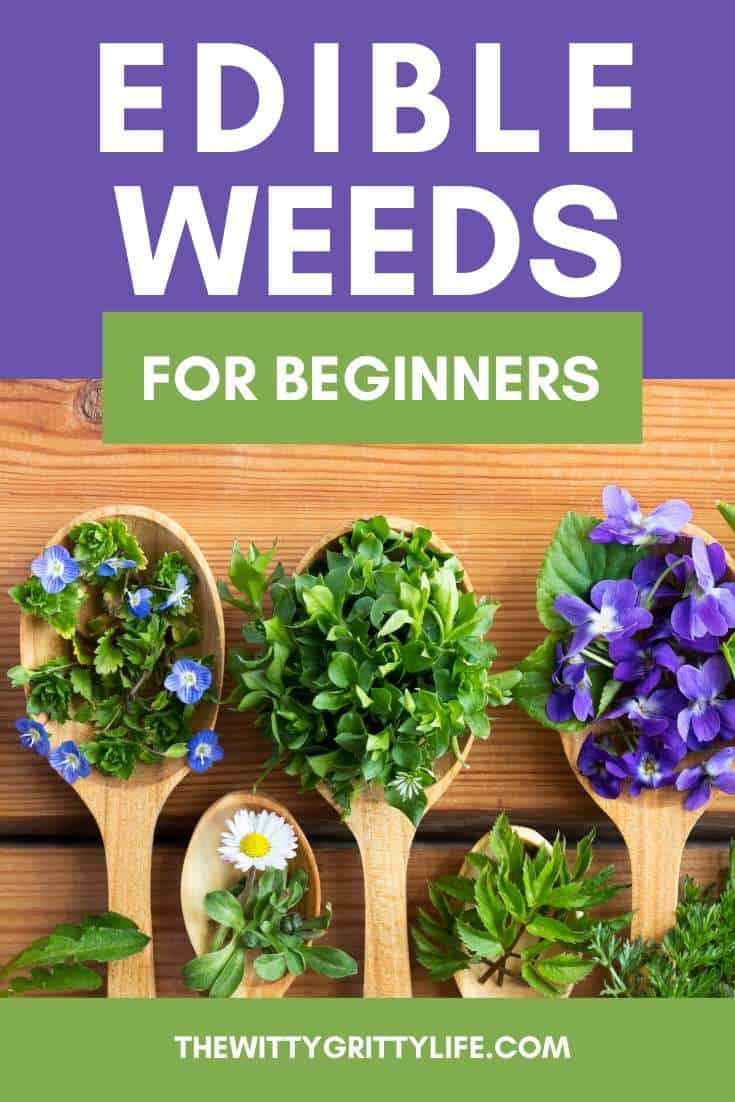
This post contains affiliate links. You can read the affiliate link policy here.
For simplicity’s sake, I am going to focus on the five most common weeds of the edible variety sprouting in my yard/garden here in the Midwest. Many of them can be found throughout North America, Europe, and Asia. What is edible will vary depending on your geographic area.
Once you are certain that you are definitely dealing with the edible weed variety, be sure to only harvest from areas that have not been treated with any kind of pesticides or from areas where animals (generally Fido) eliminate.
1. Dandelion
While dandelions are a nuisance to any homeowner desiring a pristine lawn, they are also among the most nutritious greens you can find in your own yard. Dandelion greens are high in fiber, vitamins C and B 6, thiamine, riboflavin, calcium, iron, potassium, and manganese. Other nutrients present in dandelion greens include folate, magnesium, phosphorus, and copper. When harvesting dandelion greens, go for the new tender shoots, which are a lot less bitter. For a little more hard-core weed harvesting you can roast the roots for a strong tea that makes a fine caffeine-free coffee substitute. While I have not made the dandelion root coffee for myself, I know it is a pretty tasty alternative when you are trying to quit coffee. You can purchase ready-made dandelion coffee from several brands like Teeccino or Dandy Blend.
Check this website for more in-depth information on the benefits of this common green.
What can you make with dandelion greens besides tossing a few leaves in your salad? Here is a link that contains 50 different ways to put this amazing plant to good use. You’ll never be annoyed by those dandelion shoots popping up in Spring again, I promise!
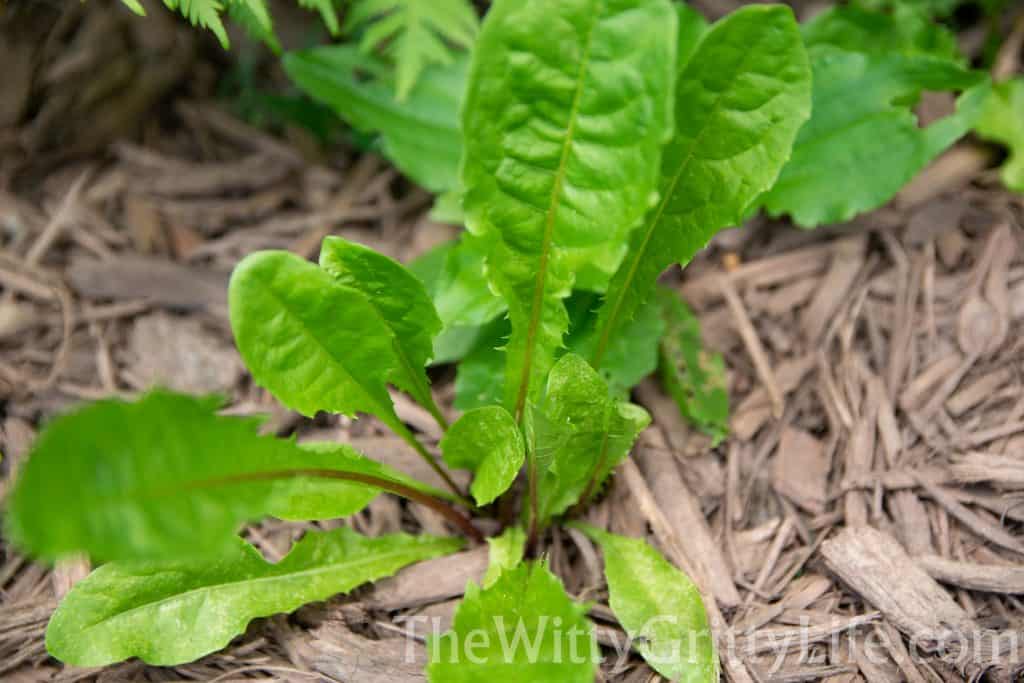
2. Purslane
Purslane (portulaca oleracea) is a succulent that sprouts up in many gardens in copious quantities. As a succulent, purslane thrives in dry, hot weather and can be harvested from about June to early fall. Purslane, with its lemony peppery flavor also happens to be a nutritional powerhouse. It is low in calories yet packed with fiber as well as high levels of omega 3 fatty acids, vitamins A, C, those in the B family, iron, magnesium, manganese, copper, potassium, and calcium.
To preserve their nutritional profile, young purslane leaves and stems are best enjoyed raw. I love sprinkling a small handful on a salad and add them to smoothies. For more ideas on how you can put the goodness of purslane to good use in your diet, be sure to check out this post with 45 ways to use purslane in a variety of recipes.
As you can see, my yard offers it up abundantly! I bet you are familiar with it as well!
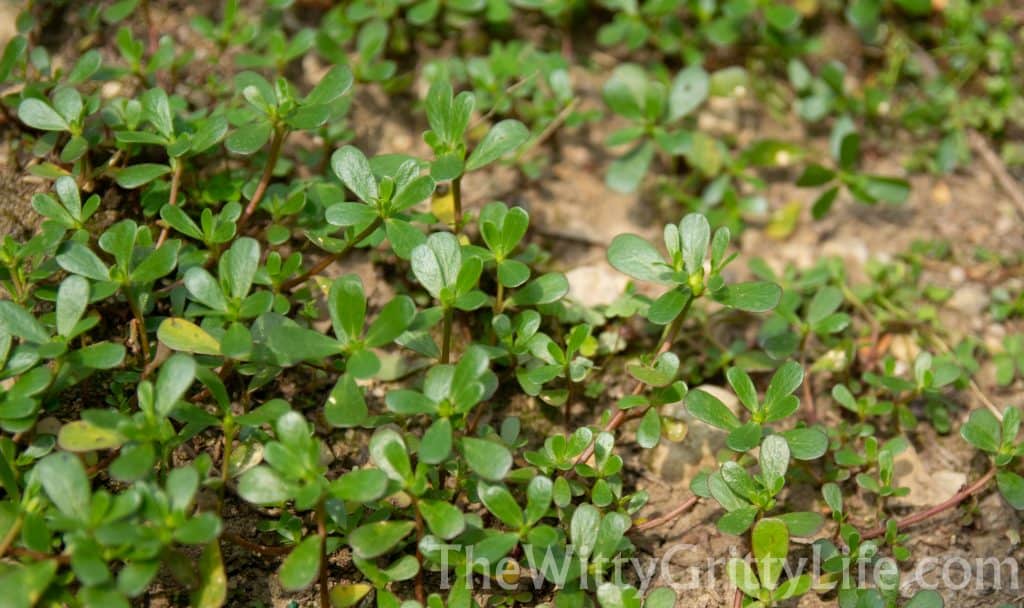
3. Plantain Leaf
Plantain (Plantago Major) plants are ancient medicinal plants indigenous and widespread throughout Europe and temperate parts of Asia but are equally common in North America. They have long been a staple in herbal medicine dating back to ancient Greek and Roman times. Plantains use as a remedy focuses on stings, bites and other skin irritations as well as ailments of the digestive and upper respiratory tract. I have been aware of the plant’s use as a remedy for blisters while hiking for some time. Just apply a leaf to the blister inside your boot for soothing, cooling relief. Read more here and here about the therapeutic benefits of plantain leaf.
Unlike some of the other weed plants commonly found in your yard, plantain is less of a culinary plant, although you can enjoy the very young and tender leaves in a salad. Older leaves are very tough and stringy and therefore not really ideal for consumption.
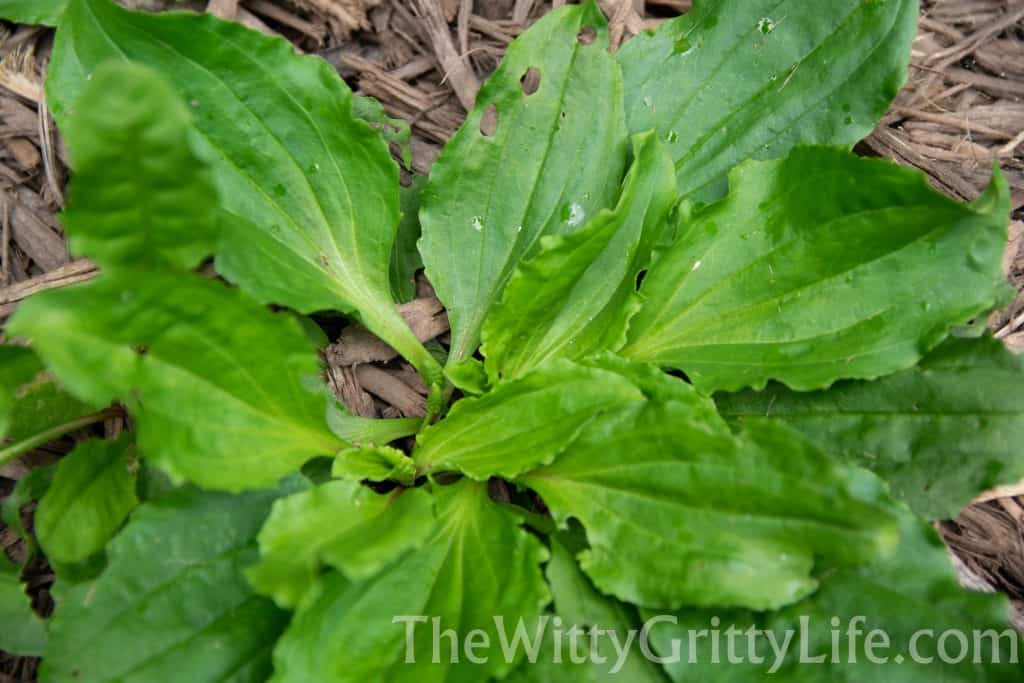
4. Chickweed
Chickweed (stellaria media) grows well in Spring, before the Summer heat sets in. It prefers moist shady areas. A native of Europe, it has become invasive in North America. Chickweed is rich in ascorbic acid, beta-carotene, calcium, magnesium, niacin, potassium, riboflavin, selenium, thiamine, zinc, copper, and Gamma-linolenic-acid. Chickweed also contains saponin which is toxic if eaten in large quantities. All parts of the plants are edible and like many of the other fresh greens listed here, best enjoyed fresh from the garden in your salad.
I bet you have seen this in your garden!
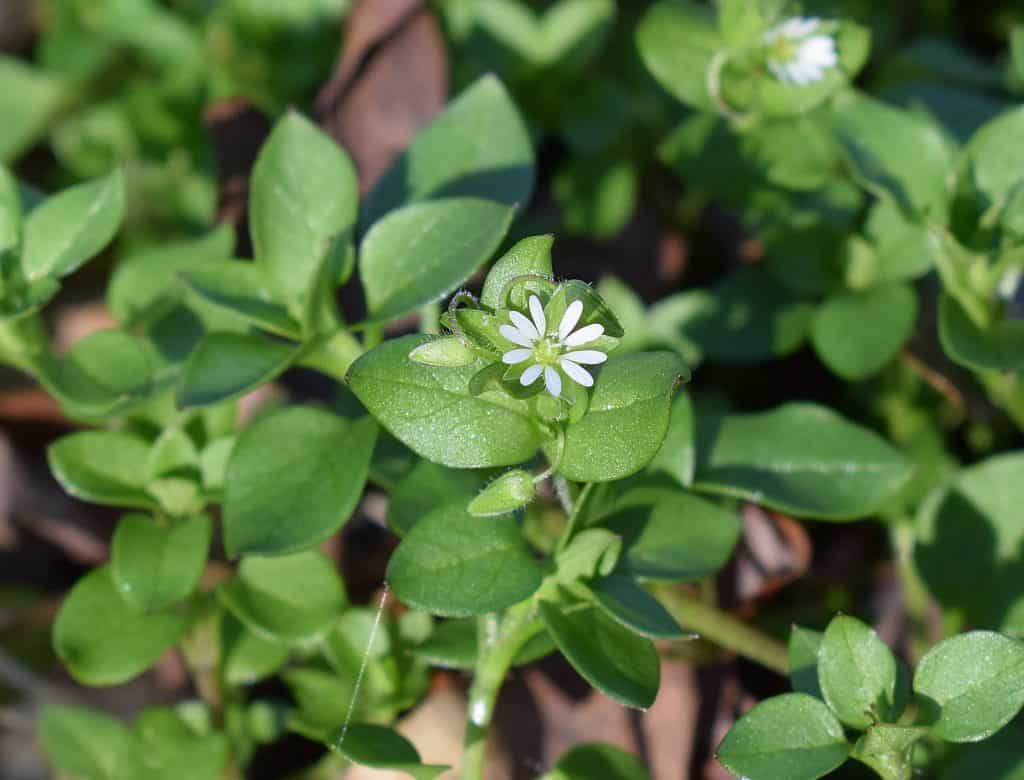
5. Wild Onion/Garlic
Wild onions and garlic sprout in early spring and are one of the very first “weeds” you can forage in your yard. The terms wild onion and wild garlic are sometimes used interchangeably. Our yard here in southern Ohio brings forth wild onions. The taste is like a cross between onions and garlic making it even more confusing. You can identify it by its shoots which look like thin chives and their bulbous white root. Wild onions will always smell like onions when harvested – leave them behind if they don’t! Both the green stem and white roots are delicious to eat. Use them raw or cooked. Wild onions have the same health benefits as all other members of the onion family.
At this writing, the time for wild onions and garlic has passed in our area, but you can see what they look like here.
You don’t have to be extremely knowledgeable to enjoy the free organic greens that usually serve to annoy you! Why not take advantage of what grows freely and effortlessly and enhance your cooking at the same time. Have you tried to forage wild greens or eaten weeds from your garden? If not, I hope you give edible weeds a try!


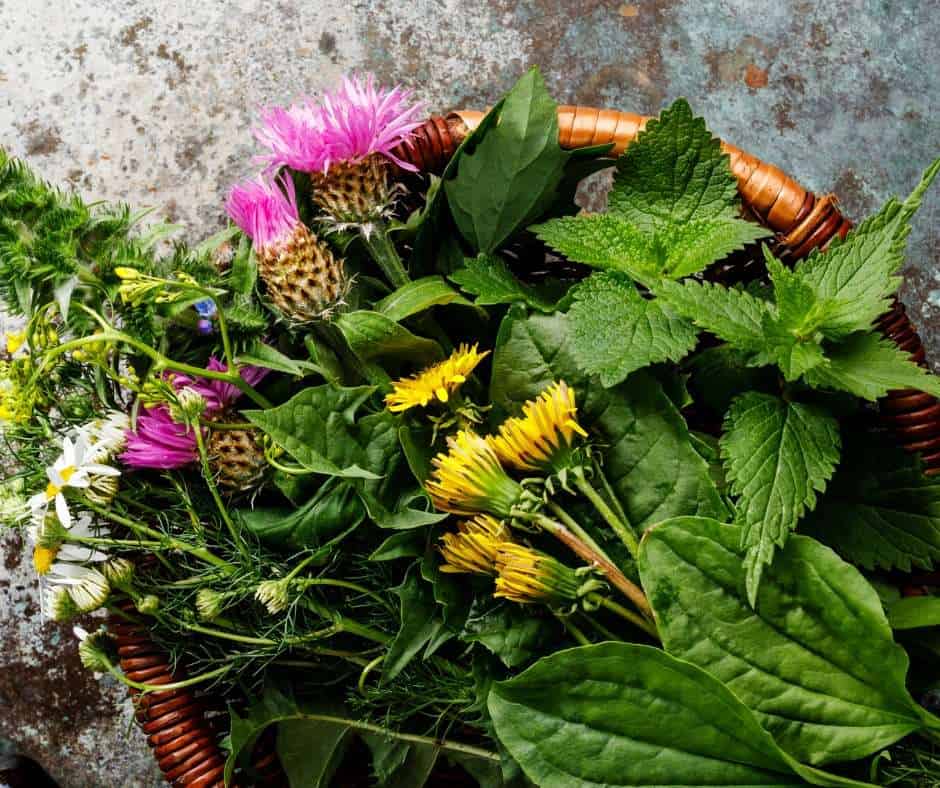


Wow, great information that I am sure most don’t know!